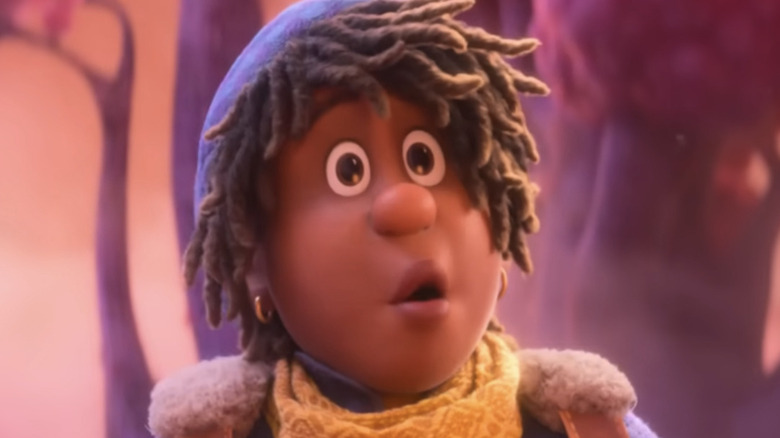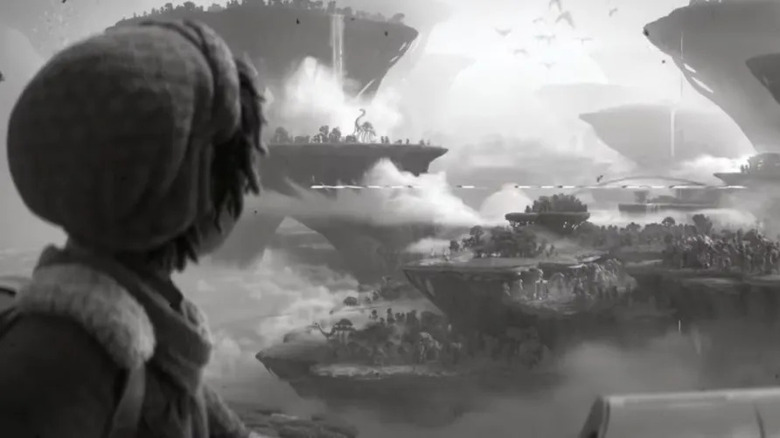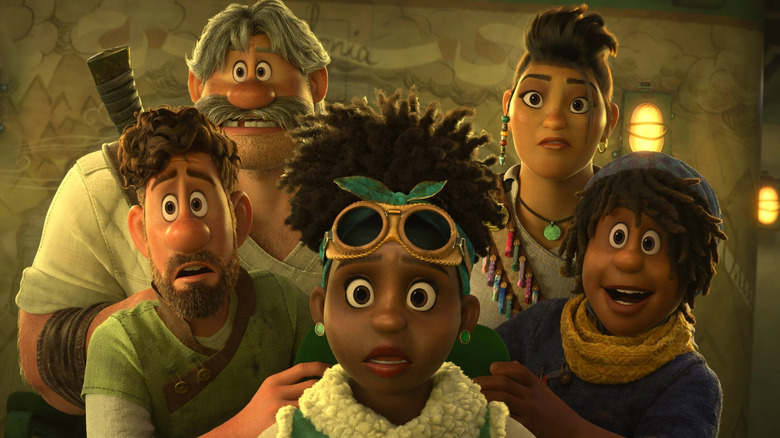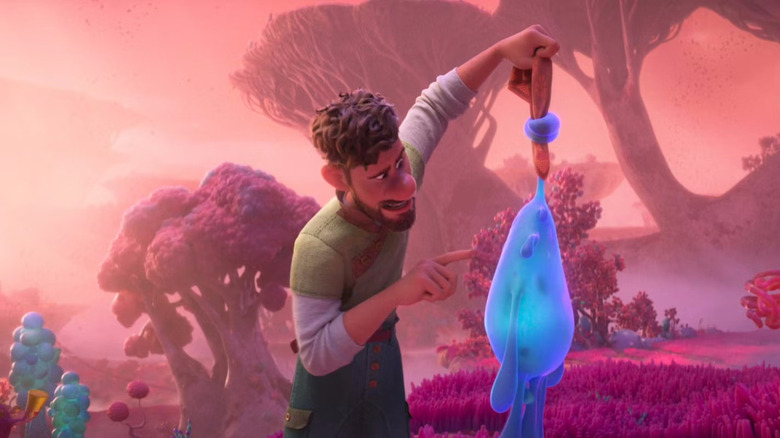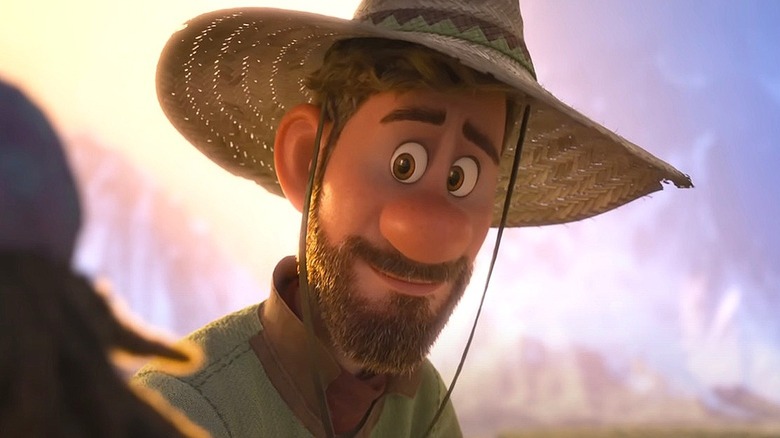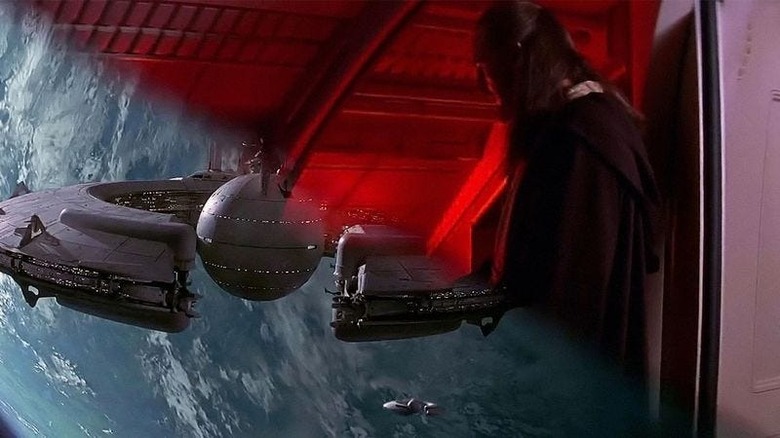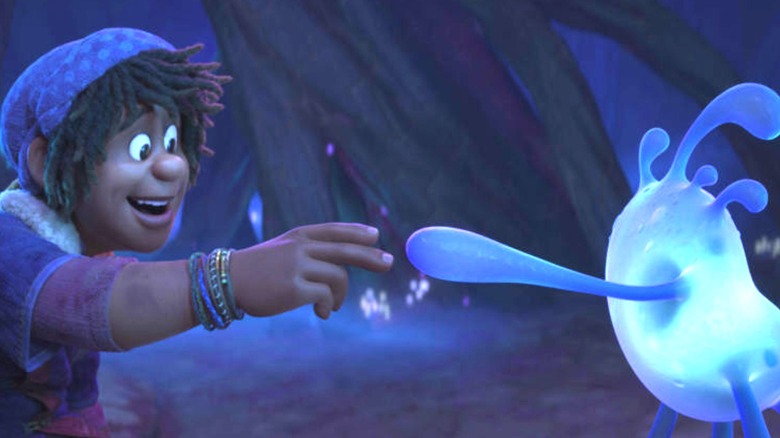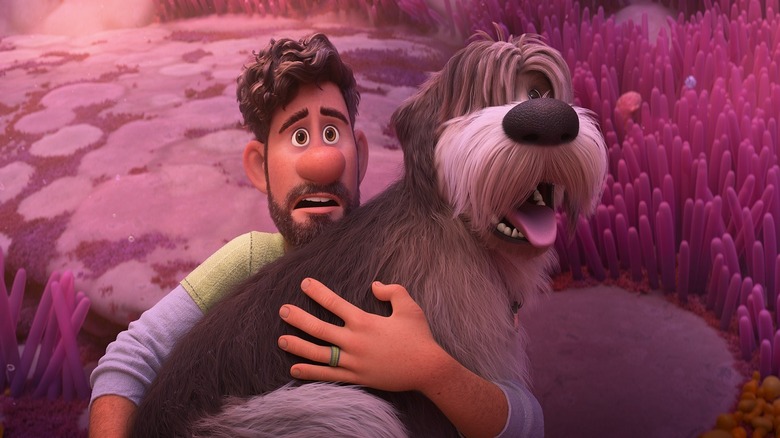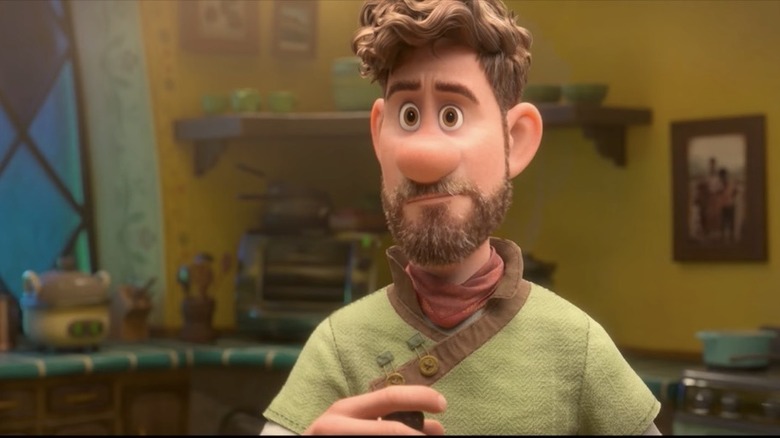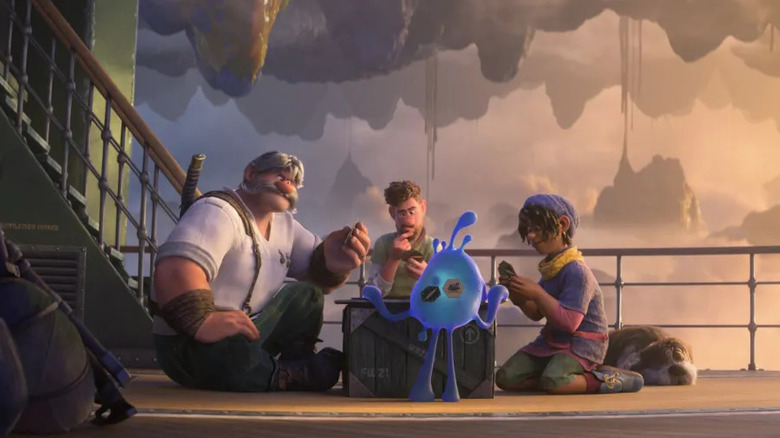Easter Eggs And References You Missed In Strange World
"Strange World" has joined the illustrious canon of Disney animated features. The original story from comes from the same team behind "Raya and the Last Dragon," with director Don Hall (also of "Big Hero Six") teaming up yet again with writer and co-director Qui Nguyen to bring an exciting and layered hero's journey to life.
The story begins with famous explorer Jaeger Clade (Dennis Quaid) and his son Searcher (Jake Gyllenhaal) on their most important expedition to go beyond the mountains of their world of Avalonia. Before reaching the destination, Searcher discovers the power-generating Pando plant and turns back, completely changing life for all Avalonians and breaking ties with his father all in one moment. Cut to years later and Searcher is a successful farmer who lives with his wife Meridian (Gabrielle Union), son Ethan (Jaboukie Young-White), and dog Legend in a thriving Avalonia. However, when Searcher is called upon to journey to save the dying Pando plant, his family can't help but join along.
"Strange World" uses this sci-fi adventure plot to tell a story about families, generational trauma, and ecological disaster. In this very dense Disney film, it might be easy to miss the small details and references to its influences hidden within. These are all the biggest "Strange World" Easter eggs and references you might have missed on your first viewing.
The first moments are in the style of 1940s and '50s adventure movies
The opening moments of "Strange World" introduce audiences to the adventures of Jaeger Clade and his son Searcher. The visual style mimics old black-and-white movies, film grain and all. During this sequence we hear an old-timey voice delivering the opening exposition in a way that harkens all the way back to the adventures from an era when Disney was the new kid on the block.
This bit of homage is more than just an ode to "old" movies, it's a reference to a very specific period in film history. The filmmakers wanted to pay homage to their favorite adventure and sci-fi movies from the 1940s and '50s. "There are lots of early 1950s-based, great black-and-white adventure films that even moved into science fiction territory, too," Roy Conli, a producer on "Strange World," told TechRadar. "That played [a] big role in how we shaped this world." Conli also mentioned 1933's "King Kong" and 1954's "20,000 Leagues Under the Sea" as other direct influences.
The plot of Strange World echoes a Jules Verne classic
You can't read a review of "Strange World" or watch an interview with its creators without seeing mention of the movie's biggest influence — science fiction author Jules Verne. The French novelist wrote some of the most famous adventure stories of the 19tth century, including "Twenty Thousand Leagues Under the Sea" and the seminal "Journey to the Center of the Earth." The latter is perhaps the biggest influence on "Strange World," as it's the Verne novel the film's plot most closely mimics. In the TechRadar interview, Conli even admits, "Jules Verne was the biggest influence."
In both "Strange World" and "Journey to the Center of the Earth," a group of explorers go on an adventure and find themselves in an unknown world beneath their own. While "Strange World" has a much more direct ecological bent to its narrative, both stories take the characters through a land of unfamiliar and mysterious creatures and eventually shoot them back out the other side. In Verne's world, there are dinosaurs, while in the "Strange World," the creatures are much more abstract. Despite this difference, in both works the inhabitants are much less of a threat than the dangers of the natural world itself.
The movie starts and ends with references to pulp magazines
In addition to the myriad literary and cinematic influences we've already touched on in "Strange World," there's one more big one: pulp fiction. No, not the Quentin Tarantino movie, but the stories that inspired that movie in the first place.
In the early 20th century — cresting in the 1950s — pulp fiction magazines were an extremely popular form of "low" entertainment. Affordable and often inconsistent in quality, pulp magazines got their name from the dirt-cheap wood pulp paper they were originally printed on around the turn of the century. Pulp characters like Doc Savage are a major influence on "Strange World," to the extent that the whole framing of the movie is within one magazine.
In the opening moments of the film, we're shown a pulp comic with Searcher and the Clades adorning the cover. The magazine then opens and transitions to the aforementioned black-and-white sequence. But the homage doesn't end there. In the movie's final moments, you get to see the magazine close, thus couching the whole story within the context of a pulp adventure.
Searcher's name is ironic
One aspect of the characters in "Strange World" that immediately stands out is the unconventional names of the Clade family. While his family consists of Jaeger, Searcher, and Meridian, Ethan is the only one whose name is not a meta commentary on their role in the story. The other three all have names that coincide with terms explorers use. Meridian is a geographical term referring to a line of longitude, most famously the central Prime Meridian, since she centers Searcher. Jaeger is another word for a hunter or a person wearing hunter's clothes, which certainly checks out with the character's personality and appearance. Of the Clade family, Searcher is the only one who doesn't live up to his name.
Searcher's name is quite ironic considering how much he seemingly hates exploring. The irony that a man named Searcher doesn't want to do any kind of searching and would rather just stay on his farm is not just a joke, but a core part of his character. Searcher's failure to live up to his name and the future his father wanted for him haunts him. His disdain for Jaeger has a direct impact on Searcher's relationship with his own son, which reveals another layer of irony — Searcher is acting exactly the way his dad did. By pressuring Ethan to grow up to be just like him, Searcher is unknowingly pushing him away and down a much different path.
Blink and you'll miss this Star Wars reference
Since "Strange World" is inspired by classic sci-fi and adventure stories, you have to admit you probably saw this one coming. At this point "Star Wars" references are pretty ubiquitous across not just Disney's output, but all modern sci-fi. "Star Wars" is cinema's defining sci-fi adventure, blending fantasy and sci-fi genres in a way that clearly served as inspiration for "Strange World." However, if you blink you might miss the reference to the iconic franchise and its filmmaking style — one that can be traced to the fact that "Strange World" is referencing the same vintage adventure serials that inspired the adventures of Luke Skywalker.
The makers of "Strange World" have hidden a pretty small Easter egg in the form of a scene transition. At one point in "Strange World," one scene transitions to the next with a wipe effect that echoes "Star Wars" in a way feels like a small nod to the "Star Wars" canon. The iconic "Star Wars" wipe George Lucas used excessively in "A New Hope" is an effect that has been recreated in other Lucasfilm projects, and even video game developers have found innovative ways to include it (via PC Gamer). The wipe transition is arguably as much of the DNA of "Star Wars" as Jedi and droids.
Of course, there's another potential reference in the fact that both movies have the same initial abbreviation "SW," but we're going to play it safe and chalk that one up to coincidence.
The alien designs were inspired by Aladdin's magic carpet
There are so many directions you can go when inventing brand new alien lifeforms for a movie. Sure, you can with the traditional big green heads or take the more adult H.R. Giger route, but wouldn't you want to create something entirely new? If you your answer is yes, then you're in good company alongside "Strange World" directors Don Hall and Qui Nguyen.
When it came to the creatures of "Strange World," the filmmakers weren't afraid to make some weird guys. In fact, most of the creatures lacked facial features, which was a move inspired by an older Disney flick, according to Hall. "I love the idea of the carpet in 'Aladdin' challenging the animators to express and give a personality to something that has no distinct features," Hall told Looper in an exclusive interview, explaining how the 1992 classic influenced the "Strange World" designs. "A lot of creatures, like the Filter Lopes, don't even have a face."
This outside-the-box thinking was key to communicating the alien nature that makes the inhabitants of the strange world seem unique and mysterious to audiences of all ages.
Legend's name is a reference to a long-time Disney animator
In "Strange World" the Clade family has a three-legged dog named Legend. He's loyal, adorable, and fearless when push comes to shove — everything you would want from a canine companion. But Legend's existence in the movie can be owed specifically to one Disney animator who wound up becoming the pup's namesake.
While "Strange World" co-director Don Hall was working on the movie, there was one long-time animator at Disney Animation Studios who kept insisting there be a dog in the film. This man was Burny Mattinson, who eventually convinced Hall to include the dog (via What's On Disney+). Mattinson, who has been with Disney since 1953, supposedly wouldn't let the issue go and soon got the whole office on board with his idea. "He kept telling me the movie needed a dog," Hall said. "Dogs just scream family, and 'Strange World' is about family."
Initially, Hall was reluctant since the gelatinous blue Splat (voiced by Alan Tudyk) already served the purpose of the cute pet character in the movie. Eventually Mattinson and his colleagues wore down the director and Legend was born. The name Legend comes from Hall's nickname for Mattinson, who became an official Disney Legend in 2008. This title is a rare honor that only goes to a handful of artists and performers across the corporation each year.
Searcher's outfit harkens back to a classic adventurer's tunic
Since "Strange World" is an original movie, its Easter eggs aren't merely callbacks to minutiae from source material or other moments in a long franchise. The movie takes inspiration far and wide, from classic pulp fiction magazines to classic video games, and wears this admiration on its sleeve. And speaking of sleeves, let us turn our attention to the clothing of the film's characters, specifically Searcher Clade.
Searcher wears a short light green top over a long sleeve white shirt. His green and white outfit is accented by the browns from his belt and collar. Okay, now take a look at the iconic design of Link from "The Legend of Zelda." The similarities in color scheme and style are profound, particularly with the iteration of Link from "Ocarina of Time." The brown that comes down from Searcher's collar is evocative of Link's sword sheath, but it's the green and white that feel like a direct reference to the Hero of Time's classic tunic.
Link's costuming, like the "Zelda" franchise as a whole, has evolved a lot over the years, but "Ocarina of Time" remains a groundbreaking classic in 3D gaming. We don't have confirmation that Searcher's outfit was an intentional Easter egg, but given all the other influences on display in "Strange World," it makes sense that the filmmakers would reference this iconic adventurer who changed gaming forever.
Primal Outpost is a fully playable tabletop game created for the movie
In "Strange World," Primal Outpost is the card game Ethan and all his friends are into. This hobby comes up more often than you might expect and bears important thematic relevance, too. Think the collection aspect of "Pokemon" cards meets the tile-based gameplay of "Catan" and you'll have a good idea of what Primal Outpost is all about.
If you watched the movie and felt particularly intrigued every time the collectible card/board game was mentioned, we have some amazing news for you. The game is real and has rule sets you can follow in real life. And while it wasn't available for sale at the time of the movie's release, there is a chance Primal Outpost will be hitting a store near you sometime in the near future.
To create Primal Outpost, the directors of "Strange World" worked with Disney designer Cory Loftis, who had previously collaborated with Hall and Nguyen on "Raya and the Last Dragon." While he was only tasked with making designs for the cards and game as part of his work on the film, Loftis went above and beyond and wound up creating a whole playable game with rules.
